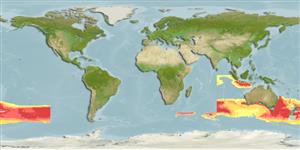>
Stomiiformes (Lightfishes and dragonfishes) >
Sternoptychidae (Marine hatchetfishes) > Maurolicinae
Etymology: Maurolicus: Greek,mauros, -os, -on = dark + Greek,lykos = wolf (Ref. 45335).
Environment: milieu / climate zone / depth range / distribution range
Ecología
marino batipelágico. Deep-water
Distribución
Países | Áreas FAO | Ecosistemas | Ocurrencias, apariciones | Point map | Introducciones | Faunafri
Southwest Pacific: off New Zealand and southern Australia.
Tamaño / Peso / Age
Maturity: Lm ? range ? - ? cm
Max length : 5.0 cm SL macho / no sexado; (Ref. 26775)
Short description
Claves de identificación | Morfología | Morfometría
Vértebra: 33 - 34. AC photophores 22-25, usually 23-24. Head 29-31% SL, eye 10-11.5% SL, upper jaw 16-18% SL, maximum body depth at pectoral fin base 22-25% SL. Stomach and hind portion of intestine intensively pigmented (Ref. 26775).
Mesopelagic species (Ref. 75154).
Life cycle and mating behavior
Maturities | Reproducción | Spawnings | Egg(s) | Fecundities | Larva
Parin, N.V. and S.G. Kobyliansky, 1996. Diagnoses and distribution of fifteen species recognized in genus Maurolicus Cocco (Sternoptychidae, Stomiiformes) with a key to their identification. Cybium 20(2):185-195. (Ref. 26775)
IUCN Red List Status (Ref. 130435)
Threat to humans
Harmless
Human uses
Herramientas
Special reports
Download XML
Fuentes de Internet
Estimates based on models
Preferred temperature (Ref.
123201): 1.9 - 3.4, mean 2.5 °C (based on 543 cells).
Phylogenetic diversity index (Ref.
82804): PD
50 = 0.5000 [Uniqueness, from 0.5 = low to 2.0 = high].
Bayesian length-weight: a=0.00479 (0.00196 - 0.01170), b=3.16 (2.95 - 3.37), in cm total length, based on LWR estimates for this (Sub)family-body shape (Ref.
93245).
Nivel trófico (Ref.
69278): 3.2 ±0.2 se; based on size and trophs of closest relatives
Resiliencia (Ref.
120179): Medio, población duplicada en un tiempo mínimo de 1.4-4.4 años (Assuming Fec < 1,000).
Fishing Vulnerability (Ref.
59153): Low vulnerability (10 of 100).
